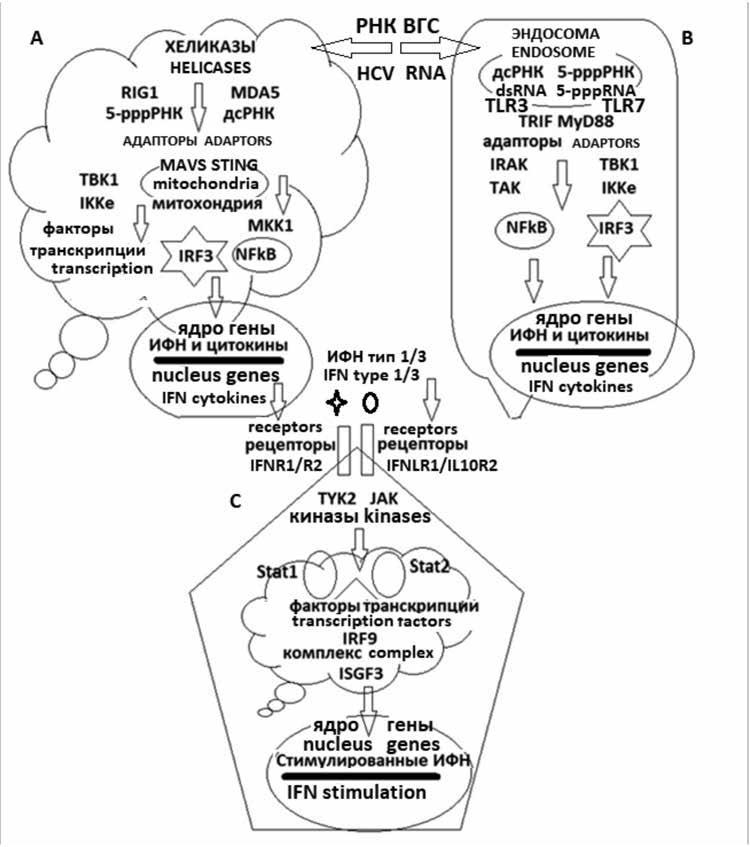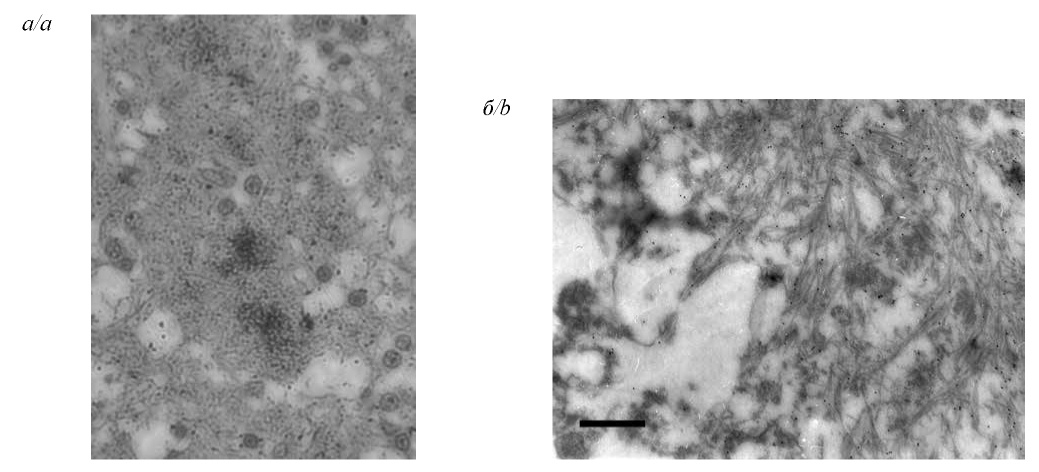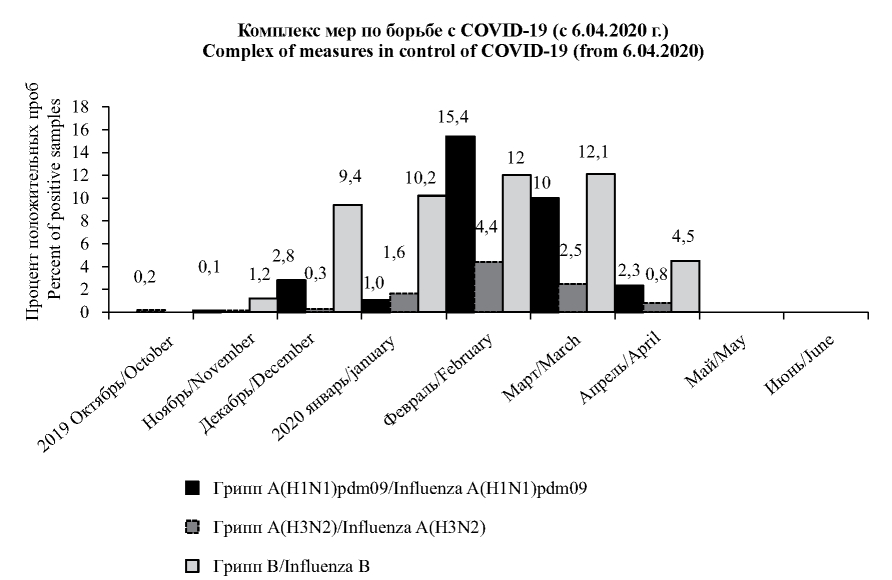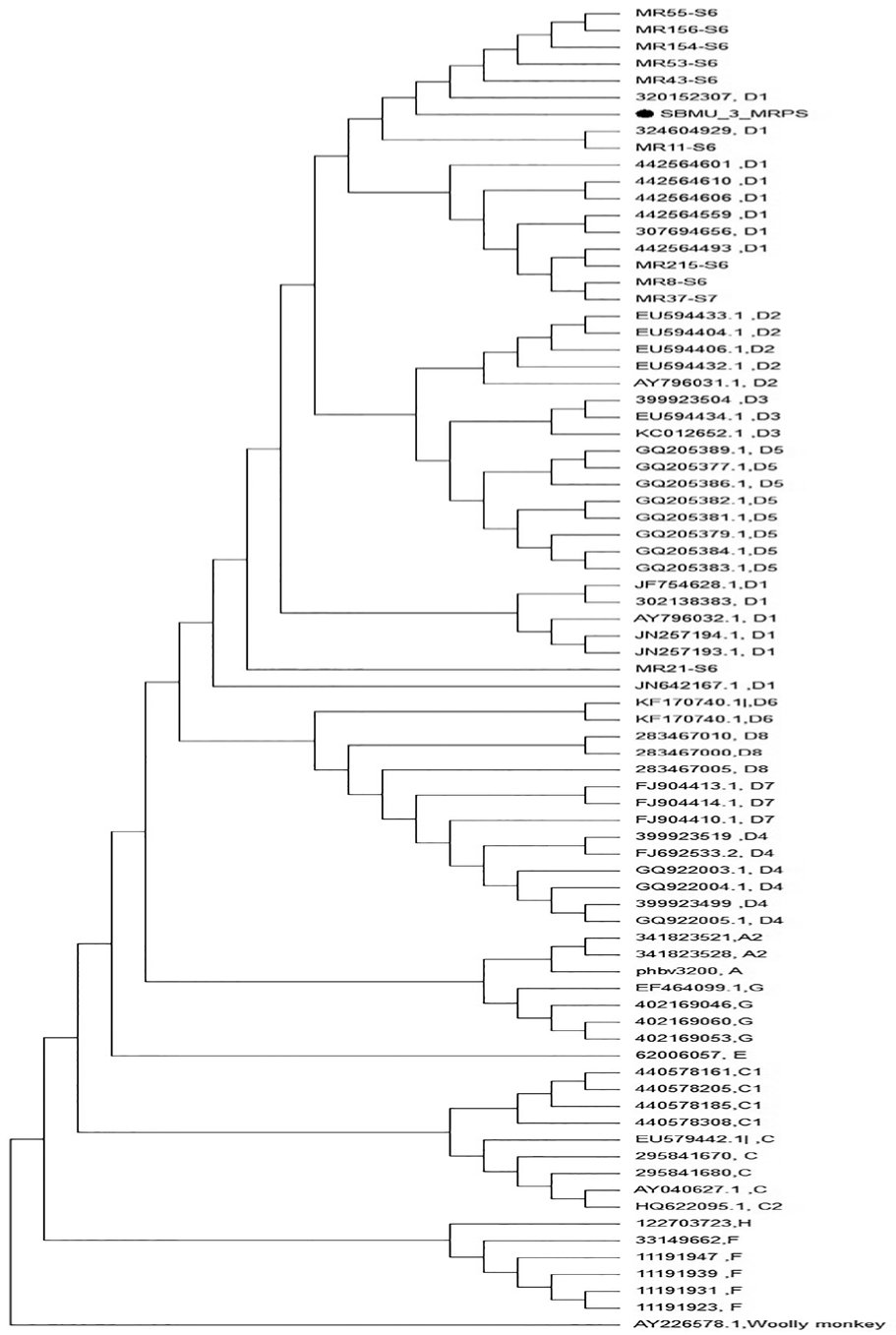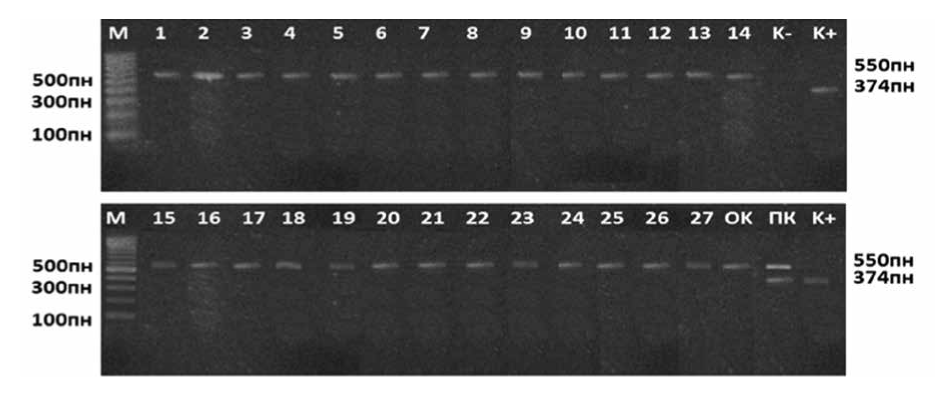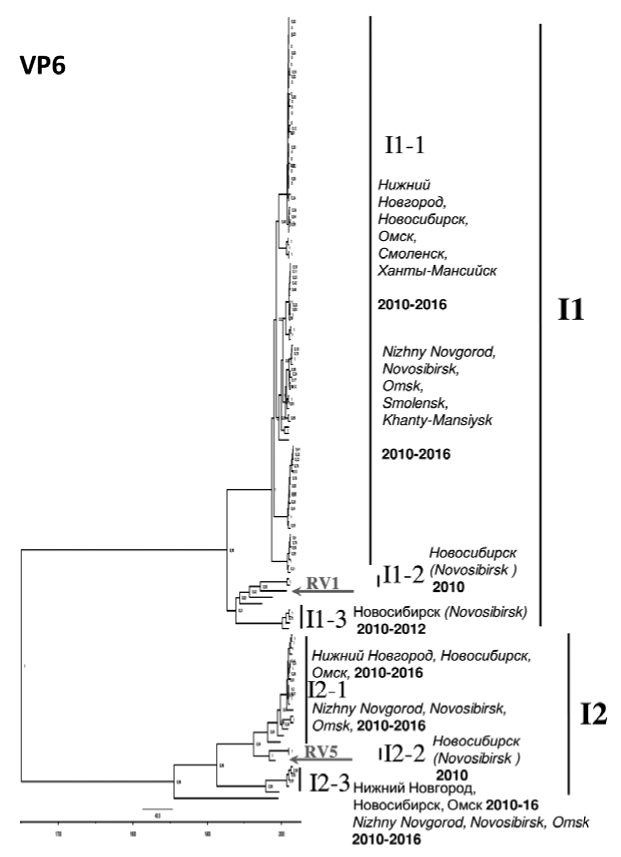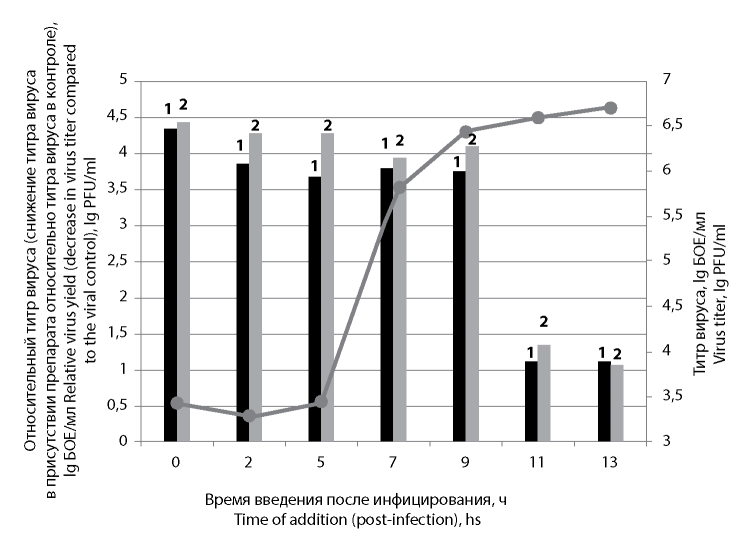Vol 65, No 6 (2020)
- Year: 2020
- Published: 08.12.2020
- Articles: 10
- URL: https://virusjour.crie.ru/jour/issue/view/47
Full Issue
REVIEWS
Hepatitis C virus (Flaviviridae: Hepacivirus: Hepacivirus C): regulation of signaling reactions of innate immunity
Abstract
Studying the regulation of signaling reactions of innate immunity by the hepatitis C virus (HCV) will help to reveal the causes of the transition of the acute form of the disease to a chronic course. The molecular mechanisms of activation by HCV RNA of innate immunity receptors TLR and RLR and signal transduction processes leading to the synthesis of IFN and inflammatory cytokines are considered. The inhibitory effects of non-structural and structural HCV proteins on immune signaling reactions are analyzed in detail. The information presented is the result of an analysis of literature data published in international databases mainly over the past 5 years. In conclusion, signaling receptors are proposed as targets for the development of new antiviral drugs with immunotherapeutic activity.
 307-316
307-316


The role of herpesviruses in development of diseases of the urogenital tract and infertility in women
Abstract
This review presents the data on the spreading of all known human herpesviruses (НHVs) in female urogenital tract. According to the WHO almost 500 million people worldwide suffer from genital infection caused by НHVs. НHVs were detected in various inflammatory diseases of female upper and lower genital tract (vaginitis and cervicitis), in extrauterine pregnancy (in fallopian tubes), in infertility (cervical channel, endometrium and ovaries). Herpes simplex virus 1 (HSV‑1) was identified for the first time in oocytes after failed in vitro fertilization (IVF). НHVs produce negative effect on the entire reproductive process from conception to childbirth. It was established that HSV, cytomegalovirus (CMV) and human herpesvirus 6 (HHV-6) markedly increase the risk of spontaneous abortion, preterm birth and stillbirth. Intrauterine НHV infection is a major cause of congenital malformations. Data on humoral and cell immunity in genital herpesvirus infections (НHVI) are also reviewed. Intravaginal HSV‑2 infection changes cell composition of vaginal mucosa, i.e., together with cells mobilized from the blood, protective role is performed by resident memory T‑cells (TRM), natural killer cells (NK‑cells) and regulatory T‑cells (Treg) whose function consists in maintaining the balance of the activities of lymphocytes. Constant НHVI spreading is largely explained by transition of primary infection to potentially reactivating latent form, since latent virus is unavailable to immune recognition and medicines. The genome editing system CRISPR/Cas9 can recognize and modify not only active but also latent viruses. The promising pilot results with the use of this system offer the possibility of developing innovative technologies for НHV elimination and НHVI eradication.
 317-325
317-325


Problems of ante mortem diagnostics of prion diseases
Abstract
The review presents the state-of-the-art on the problem of diagnosis of prion diseases (PD) in humans and animals with a brief description of their etiology and pathogenesis. We pointed out that understanding the nature of the etio logical agent of PD determined their zoonotic potential and led to the development of highly specific immunological diagnostic methods aimed at identifying the infectious isoform of prion protein (PrPd) as the only marker of the disease. In this regard, we briefly summarize the results of studies, including our own, concerning the conversion of normal prion protein molecules (PrPc) to PrPd, the production of monoclonal antibodies and their application as immunodiagnostic reagents for the post-mortem detection of PrPd in various formats of immunoassay. We also emphasize the issues related to the development of methods for ante mortem diagnostics of PD. In this regard, a method for amplifying amino acid sequences using quacking-induced conversion of PrPc to PrPd in real time (RTQuIC) described in details. The results of recent studies on the assessment of the sensitivity, specificity and reproducibility of this method, carried out in various laboratories around the world, are presented. The data obtained indicate that RT-QuIC is currently the most promising laboratory assay for detecting PrPd in biological material at the preclinical stage of the disease. The significant contribution of US scientists to the introduction of this method into clinical practice on the model of diagnosis of chronic wasting disease of wild Cervidae (CWD) is noted. The possible further spread of CWD in the population of moose and deer in the territories bordering with Russia, as well as the established fact of alimentary transmission of CWD to macaques, indicate the threat of the appearance of PD in our country. In conclusion, the importance of developing new hypersensitive and/or selective components of known methods for PrPd identification from the point of view of assessing the risks of creating artificial infectious prion proteins in vivo or in vitro, primarily new pathogenic isoforms (“strains”) and synthetic prions, was outlined.
 326-334
326-334


ORIGINAL RESEARCHES
Peculiarities of the influenza and ARVI viruses circulation during epidemic season 2019–2020 in some regions of Russia
Abstract
Introduction. The surveillance of influenza viruses in ARVI structure and study of their properties in epidemic season 2019–2020 in Russian Federation are actual for investigations due to tasks of Global Influenza Strategy initiated by WHO in 2019.
Material and methods. The data of epidemiological surveillance on influenza- and ARVI-associated morbidity and hospitalization in different age groups of population were analyzed; virological, genetic and statistical methods were used.
Results. Preschool children were involved in epidemic the most. Meanwhile, the highest rate of hospitalization was observed in patients of 18–40 years old. Influenza A(H1N1)pdm09 virus dominated in etiology of ARVI in hospitalized patients and pneumonia. The role of respiratory viruses in severe cases of pneumonia and bronchoalveolar syndrome in children was shown. The differences in spectrum of circulating viruses caused ARVI in different regions of Russia were found. Influenza A(H1N1)pdm09 and B/Victoria-like viruses were the main etiological agents that caused of epidemic; its activity among all ARVI was 7.3 and 8.0%, respectively. The differences in antigenic properties of influenza A(H3N2) and B epidemic strains compared to vaccine viruses were found. The populations of epidemic strains were presented by following dominant genetic groups: 6B1.A5/183P for A(H1N1)pdm09, 3С.2а1b+137F for A(H3N2) and V1A.3 line B/Victoria-like for B viruses. The good profile of epidemic strains susceptibility to anti-neuraminidase inhibitors has been saved. The most of the studied influenza strains had the receptor specificity characteristic of human influenza viruses.
Conclusions. Obtained results identified the peculiarities of viruses caused the influenza and ARVI in epidemic season 2019–2020 in different regions of Russia. These results suggested the important role of influenza A(H1N1) pdm09 in severe cases and pneumonia in adults 18–40 years old. The continuing drift in influenza viruses was found, which, apparently, could not but affect the efficacy of vaccine prophylaxis and was also considered in the recommendations of WHO experts on the composition of influenza vaccines for the countries of the Northern Hemisphere in the 2020–2021 season.
 335-349
335-349


Hepatitis B Virus (Hepadnaviridae: Orthohepadnavirus: Hepatitis B virus) among Hospitalized Mentally Disabled Patients is not transmitted by their nurses or family members
Abstract
Background. Prevalence of hepatitis B virus (HBV) infection has been reported to be higher in the institutionalized mentally disabled patients than that of the general population previously reported in Iran. This study aims to investigate HBV infection among nurses and families of the hospitalized mentally disabled patients.
Material and methods. This study was conducted on 110 nurses and family members of the mentally disabled patients who were hospitalized in five residential care centers of Tehran. The presence of hepatitis B surface antigen (HBsAg) and hepatitis B core antibody (HBcAb) was examined using the enzyme-linked immunosorbent assay (ELISA). Afterwards, HBV DNA was extracted, and then propagated via a nested polymerase chain reaction (PCR) and specific primers. Finally, a phylogenetic tree was constructed using the neighbor-joining method to compare virus genomes in the nurses’ serum with other isolated HBVs worldwide.
Results. Out of 102 studied nurses, three (3%) were positive for HBsAg (100% female). Also, no patient was positive for the HBV genome, while eight (7.3%) nurses were positive for HBcAb including two (25%) males and six (75%) females. Genome sequencing of one DNA positive sample showed that the isolated virus from this patient contained sub genotype D1 and subtype ayw2. The results of none of the family members were positive for HBsAg, HBcAb, or HBV DNA.
Conclusion. This study showed a higher prevalence of HBsAg among nurses (3%) compared to the Iranian general population (1.7–2.1%). The virus isolated from the nurses belonged to subgenotype D1 and subtype ayw2 in accordance with previous Iranian reports. Also, there was no drug-resistant or vaccine-escape mutations in the obtained viral genome. Moreover, low immune pressure on the virus in the asymptomatic chronic HBV patients might be responsible for low nucleotide divergence among the derived HBV genome.
 350-356
350-356


Study of the teratogenicity of the vaccine strain of the Rubella virus «Orlov-V» (Matonaviridae: Rubivirus: Rubella virus) in experience on rhesus macaques
Abstract
Introduction. Rubella virus has pronounced teratogenic properties that can cause generalized and persistent intrauterine infection of the fetus. As a result, the control of the loss of teratogenicity inherent in «wild-type» virus strains is a necessary stage of a preclinical study of the vaccine strain for a live attenuated rubella vaccine.
The purpose of the study is to comprehensively study the teratogenic properties of the vaccine strain of rubella virus «Orlov-V» in the experiment on rhesus macaques.
Material and methods. Seronegative to rubella virus female rhesus macaques in early pregnancy at the age of 4–7 years (n = 13) were used in the experiment. Animals of the experimental group (n = 9) received single immunization intramuscularly with a preparation from the «Orlov-V» strain. The control group of the monkeys (n = 3) were immunized with a commercial vaccine containing Wistar RA27/3 strain. The female of the control group (n = 1) was injected with a solvent used in the rubella vaccine. Study of possible teratogenic properties of vaccine strains of rubella virus was carried out using a complex of clinical, immunological, pathomorphological and virological methods. Clinical observations were made within 3 months after the monkeys’ birth. Determination of antibody titers in the blood serum of immunized monkeys was performed in HI test on the 28th–30th day after infection. The ELISA method was applied to determine IgM antibodies in the blood serum of newborns within the first month of life. Detection of rubella virus RNA was performed by PCR with electrophoretic detection of amplicons.
Results. No markers of congenital rubella infection were found in infants born from monkeys vaccinated during the pregnancy. It is shown that PCR can be an informative method to confirm the absence of teratogenic properties of vaccine strains of rubella virus.
Discussion. The obtained data demonstrated that vaccine strains of the «Orlov-V» rubella virus and Wistar RA27/3 have lost their teratogenic properties. The possibility of using an alternative strategy for preclinical assessment of specific safety of antiviral vaccines including a complex of clinical, immunological, pathologic and virological methods instead of the classical pathologic method is discussed.
Conclusion. The results obtained in this study showed the absence of teratogenic properties and high immunogenic activity of the vaccine strain of rubella virus «Orlov-V».
 357-363
357-363


Phylodynamic characteristics of the Russian population of rotavirus А (Reoviridae: Sedoreovirinae: Rotavirus) based on the VP6 gene
Abstract
Introduction. Rotavirus A is one of the leading causes of acute gastroenteritis in children in the first years of life. Rotavirus infection is currently classified as a preventable infection. The most abundant rotavirion protein is VP6.
Material and methods. Phylogenetic analysis and calculation of phylodynamic characteristics were carried out for 262 nucleotide sequences of the VP6 gene of rotavirus species A, isolated in Russia, using the BEAST v.1.10.4 software package. The derivation and analysis of amino acid sequences was performed using the MEGAX program.
Results. This study provides phylodynamic characteristics of the rotaviruses in Russia based on the sequences coding VP6 protein. Bayesian analysis showed the circulation of rotaviruses of three sublineages of genotype I1 and three sublineages of genotype I2 in Russia. The level of accumulation of mutations was established, which turned out to be similar for genotypes I1 and I2 and amounted to 7.732E-4 and 1.008E-3 nucleotides/site/year, respectively. The effective population sizes based on nucleotide sequences of the VP6 I1 and I2 genotypes are relatively stable while after the 2000s there is a tendency of its decreasing. Comparative analysis of the amino acid sequences in the region of the intracellular neutralization sites A (231–260 aa) and B (265–292 aa) made it possible to reveal a mutation in position V252I in a proportion of Russian strains of genotype I1 some strains of genotypes I1 and I2 had mutation I281V. These substitutions were not associated with any sublineages to which the strains belong. The analysis of three T-cell epitopes revealed four amino acid differences (in aa positions 305, 315, 342, 348) that were associated with the first or second genogroup.
Conclusion. Based on the phylodynamic characteristics and amino acid composition of antigenic determinants, it was concluded that the VP6 protein is highly stable and could potentially be a good model for development of a rotavirus vaccine.
 364-372
364-372


Antiviral effect of novel purine conjugate LAS-131 against Herpes simplex virus type 1 (Herpesviridae: Alphaherpesvirinae: Simplexvirus: Human alphaherpesvirus 1) in vitro
Abstract
Introduction. Herpes simplex viruses type 1 (HSV-1) are extremely widespread throughout the world and, similar to other herpesviruses, establish lifelong persistent infection in the host. Reactivating sporadically, HSV-1 elicits recurrences in both immunocompetent and immunocompromised individuals and can cause serious diseases (blindness, encephalitis, generalized infections). The currently available antiherpetic drugs that aimed mainly at suppressing replication of viral DNA are not always effective enough, for example, due to the development of drug resistance. As we showed earlier the newly discovered compound LAS-131 exhibits the strong and highly selective inhibitory activity against HSV‑1, including strain resistant to acyclovir (selective index, SI = 63). The presence of LAS-131 at a concentration of 20 μg/ml leads to a decrease in the titer of HSV-1 (strain L2) by 4 lg in a one round of HSV-1 replication.
Material and methods. To establish the step(s) of the virus life cycle that is sensitive to the action of LAS-131, we have applied a widely used approach, that made it possible to determine how long the addition of a compound can be postponed before it loses its antiviral activity (time-of-addition assay), and to compare this indicator with the crucial time of application of inhibitors with a well-known mechanism of action (in cell culture).
Results. It has been shown for the first time that LAS-131 retains a pronounced antiviral effect when introduced into the experimental system no later than 9 hours post-infection (p.i.). However, LAS-131 does not affect the release of HSV-1 from the cell.
Discussion. Together with published data on the termination of the synthesis of viral DNA 9–12 h after the adsorption in a cell culture infected with HSV with a high multiplicity (≥1 PFU/cell), our results suggest that LAS-131 interferes the life cycle of HSV-1 during synthesis of viral DNA. Further studies of the mechanism of action are necessary to establish definitely the biological target for this compound,.
 373-380
373-380


INFORMATION
 381-382
381-382


 383-384
383-384











